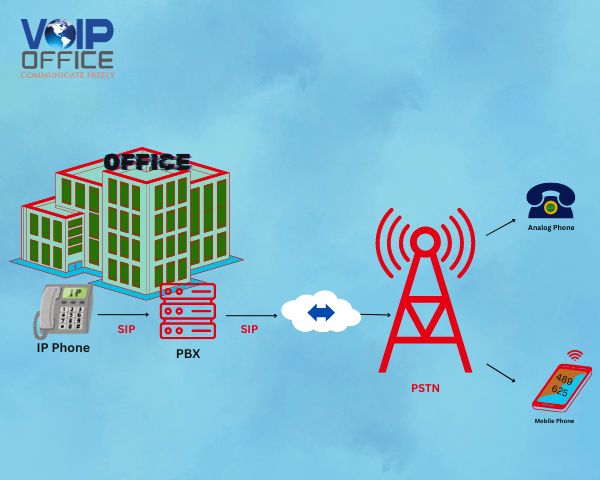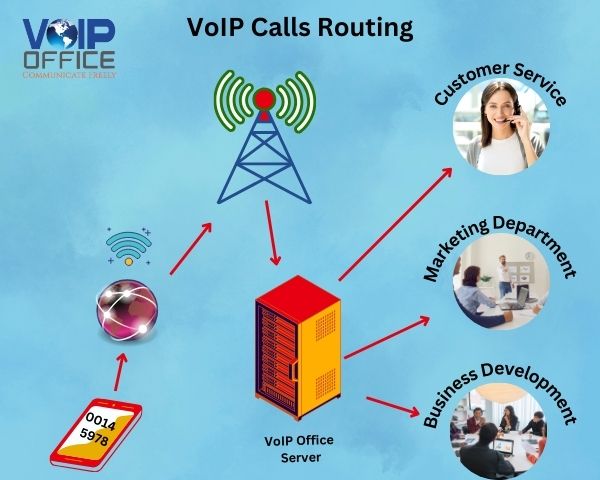How VoIP Calls Are Routed: In the present-day scenario, VoIP is the trending technology that has burst out in today’s tech world. Right from consumers to business houses that are in operation, are grappling to switch over from the PSTN (Public Switched Telephone Network).
The technology of VoIP (Voice over Internet Protocol) makes use of broadband internet connection and allows the users to make voice calls instead of the usual traditional analog phone lines.
The service providers of VoIP allow users to make voice calls using their service, while few of the providers allow them to call anyone, be it long-distance calls, local calls, or even international numbers.
VoIP Office communication service providers work by making use of the user’s computer or even using a special VoIP phone, whereas there are providers that allow the use of a traditional phone by connecting it to a VoIP adapter. Given its flexibility, extensibility, and its compatibility with other Internet Protocol (IP) based systems, VoIP has become more adaptable to the modern needs of communications than the previous old traditional telephonic system in the bygone era.
VoIP is one of the most significant tools as it helps in consolidating all the existing communication technologies like audio, video and text-based communications into one combined system. This is of most importance to those organizations as it helps the existing teams by not having to work with multiple applications for communication purposes.
How VoIP Calls Are Routed: Benefits Of VoIP
A few benefits of VoIP include:
Cost Cutting
Switching to VoIP saves about almost 50% of the monthly communication cost.
Low Maintenance Cost
The providers of VoIP take care of monitoring, upgrading and maintaining the software offsite usually in the cloud. That means the maintenance cost is reduced to a great extent as it works with both desktop and mobile equipment.
High Portability
It is one of the important benefits especially for those teams who work in remote, mobile or even in hybrid settings, due to its operation online.
The users can access the phone systems from any location that has an internet connection spreading across different time zones and locations across the world 24×7.
VoIP works with all types of desktops or mobile device connected to the internet. It offers Android and iOS apps, softphone connection and even web browser calling.
Ease Of Scalability
It is easy for the authorized person to add new team members to their existing team without having to wait for an IT.
The new team member can be easily added over an invitation by email and these newly added members can be assigned a brand-new phone number or even a shared one.
Voice Quality
Due to the evolving of HD voice, automatic adjustment of bandwidth, evolution of tier-1 carriers
Over the last ten years, however, VoIP call quality has advanced thanks to HD voice, global points of presence, and partnerships with tier-1 carriers, and automatic bandwidth adjustment.
Present VoIP providers deliver Service Level Agreement (SLA) uptime of 99.9%.
Basics Of VoIP
How VoIP Calls Are Routed: While making a phone call using a traditional phone, physical equipment is compulsory. Factors like traffic, distance and availability adds to the cost of the telephone call made. Along with a dedicated channel. The traditional system makes use of copper wires in their telephone lines to send audio.
Whereas in VoIP, the process named “packet-switching” is used, where in the voice data gets transferred and assembled after each conversation at high speed that ensures, there is continuity in call without any breakpoints, thus becoming the most cost-effective way of communication.
VoIP uses codec technology that decides the quality of the audio. It helps in compressing the phone calls made through voice over internet protocol. These codecs make use of open-source algorithms. A codec takes up the data by encoding it in another form and then decodes it at the egress point while communicating. Codecs consist of an encoder and a decoder.
The encoder compresses the media file, while the decoder decompresses it. Many codecs are designed to handle various types of communication, such as audio and video.
How VoIP Calls Are Routed: Role Of IP Addresses in VoIP Communication
How VoIP Calls Are Routed: VoIP (Voice over Internet Protocol) technology routes phone calls over the internet. To send the right caller data to the right recipient the VoIP solution requires devices with visible IP addresses.
VoIP Call Components
VoIP technology helps in making telephone calls via the internet rather than the traditional phone line. Voice over internet protocol is cheaper too. A few components of VoIP are:
A Voice over Internet Protocol (VoIP) system consists of several components that work together to facilitate voice communication over the internet. Here are the main components of a VoIP system and how they differ from each other:
IP Phones/Softphones
IP phones are physical devices that look like typical traditional telephones. But they transmit the user’s voice data through the internet.
Softphones are applications installed on computers or mobile devices that allow users to make voice calls over the internet.
VoIP Gateway
VoIP gateways convert analog voice signals into digital data packets for transfer via the internet. These gateways control the transformation of digital data packets back into analog signals while transferring over traditional phone lines.
The gateway acts as the interfaces between the VoIP networks and traditional phone lines.
VoIP Private Branch Exchange (PBX)
The VoIP PBX is the central system that takes care of the voice transmission within a given organization. It mainly takes care of routing the voice calls, managing extensions. Apart from that it provides various other features like call forwarding, voicemail and even auto-attendant. These PBX systems make use of internet protocol to direct the calls internally.
VoIP Servers
These servers’ handles signaling of calls, routing the call, and various other functions of the communication that works well in a VoIP network. They take care of the maintenance, establishing and terminating the calls.
The servers in the VoIP network take care of the protocols of communication along with data traffic within.
Session Border Controllers (SBCs)
SBCs manage media streams and signaling between VoIP networks, ensuring secure and reliable communication across different network boundaries. They also provide NAT (network address translation) traversal along with encryption.
SBCs ensures that the communications between various sessions that takes place between different networks in VoIP ensures the compatibility in inter operating along with enhanced security.
Analog Telephone Adapter (ATA)
It is a device that connects analog telephones, fax machines, or similar equipment to a network, enabling communication over the internet.
This adapter lets its users use their existing telephones in the same way as using traditional telephone networks. Here the internet gets flexible and these old existing analog equipment helps in reducing new phone expenses.

Importance of Session Initiation Protocol (SIP)
Session Initiation Protocol (SIP) helps voice to travel flawlessly over the internet. Its protocol helps in arranging the real-time video and audio, be it a voice call, video chat or even a conference bridge. This protocol helps in initiating, maintaining and terminating communication sessions that also include video, voice and various existing messaging applications. It is mainly used in Internet telephony, IP phone systems as well as phoning using a mobile over LTE (VoLTE) (Voice over Long Term Evolution)
It helps in facilitating remote work setup as it makes a geographically secure distribution of communication possible. The employees can make use of the same communication tools used in the office. Reducing communication barriers is a global venture as it helps the organizations to communicate with their partners across the globe. Regardless of the technology used, SIP enables devices to communicate efficiently and seamlessly across different platforms.
It also supports future-proofing by incorporating new features and protocols as communication needs evolve. Small business organizations adopt new technologies quickly and this helps them to stay ahead.
How VoIP Calls Are Routed: VoIP Call Routing
VoIP call routing is almost like a call forwarding, but with a higher rate of configurability and availability. You can program one phone number to dial the cell numbers of every member in the department. The caller connects to the first person who answers the call.
How VoIP Calls Are Broken Down
- While speaking over a VoIP phone. The system captures the user’s voice signal and converts it into a digital format using Analog-to-Digital Conversion (ADC).
- The VoIP system breaks down the digital data into smaller packets. Similar to the files usually sent over the internet. The system labels these data packets with information such as the caller and recipient. These data packets make use of the internet connection and travel to the VoIP servers.
- Based on the recipients number the VoIP provider works like the switchboard. Figures out sends the call using specialized software codecs that compress the data. Which saves the bandwidth along with ensuring seamless call quality.
- At the receiver’s end, be it a VoIP device or even a traditional phone or even a mobile device. The system reassembles the received data packets and converts them into an analog signal using a DAC (Digital-to-Analog Converter).
- The recipient hears the caller’s voice through the speaker or handset, continuing the VoIP conversation.
Conclusion
In common man’s terms VoIP routing makes use of internet broadband connection to make voice calls worldwide.
This process involves converting voice signals from analog to digital. The recipient’s device collects these digital data into analog signals that make the voice call crystal clear to ears.
Due to its cost saving factor, call waiting, call forwarding, and various other benefits VoIP calls are becoming popular.


Pingback: How to Use VoIP on Android Phone -
Pingback: VoIP Phone: Can A Regular Phone Be Used as a VoIP Phone -
Pingback: VoIP Termination Services -
Pingback: Difference Between UCaaS, CCaaS and the Impact on Businesses -